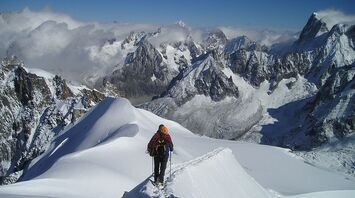How Chamonix became the world's most famous ski resort

Before this historic event, the city was a world center of mountaineering - the allure of climbing some of Europe's highest, most challenging, and awe-inspiring peaks had attracted climbers for almost two hundred years, including the English aristocracy and members of the Alpine Club. Chamonix was also a popular destination for members of the British Ski Club, led by Sir Henry Lunn, founder of the Lunn Poly travel company.
As snow and ice sports gained popularity in the late 19th century, the International Olympic Committee was persuaded to create a winter version of the Olympics, and Chamonix was chosen as the inaugural venue for the 11-day event. The 1924 Games included figure skating and speed skating competitions. This was reported by yahoo.com.
Competitions included cross-country skiing, figure skating, speed skating, hockey, biathlon, ski jumping, bobsledding, curling, and military patrol.
The competition required a significant amount of money to build a ski jump, a 36,000-square-meter ice rink, and a bobsleigh track - the ski jump in Mont aux Bossons is still used occasionally, but the ice rink and bobsleigh track are long gone.

Great Britain took sixth place in the medal standings, with the Scandinavian countries dominating the medal count then as they do now. Shortly before the opening of the Games, over 1.5 meters of snow fell in a single day, followed by a thaw that triggered an avalanche, blocking the local railroad and transforming the Olympic rink into a lake. Fortunately, the low temperatures returned in time for the opening ceremony, which featured 300 athletes from 16 countries and was watched by 10,000 spectators.
The first Winter Olympics provided Chamonix with a great opportunity to promote itself as a year-round destination. Until then, tourists had mostly visited only in the summer, but over the next decades, the city and the surrounding mountains would become one of the world's premier winter sports destinations.
In the Chamonix Valley, the Brévent cable car was built between 1928 and 1930, followed by a series of ski lifts, and in 1955 by the impressive Aiguille du Midi Teleféric, then the highest cable car in the world, reaching a breathtaking height of 3,842 meters.
It provided climbers with faster and easier access to the Mont Blanc mountain range, allowed skiers to descend to the Valle Blanche - an exhilarating and impressive 20-kilometer ski run down the Mer de Glace glacier - and gave day-trippers the opportunity to see Mont Blanc's magnificent glacial alpine landscape up close. Further down the valley, the Grand Mont Blanc ski area opened in 1963, offering access to some of the world's most challenging freeride runs.
Chamonix has further solidified its status on the scene thanks to the annual FIS Alpine World Cup, numerous FIS Alpine World Cup Kandahar events, and, most recently, the Freeride World Cup.
The city remains a pilgrimage site for many skiing enthusiasts, drawing winter sports enthusiasts from around the world eager to test their skills on the ski slopes of the region. Alongside avid locals, there are many British, Scandinavians, Americans, and Australians, as well as a small number of guests from other countries.

To meet diverse needs, Chamonix offers a wide range of options, from Michelin-starred restaurants to curry houses and burger bars, five-star hotels and two-story houses, hipster bars and breweries, to several nightclubs and casinos. It is easily accessible thanks to the main road that tunnels under Mont Blanc to Italy and the aforementioned rail line that provides connections to Geneva, Paris, and London.
The Ski Club of Great Britain is offering an off-piste Chamonix adventure trip starting from £1595 for intermediate skiers and above, available for dates in February and March. The price includes seven nights' chalet accommodation, six nights' bed and breakfast, and five days with mountain guides. Travel expenses are not included. Visits to the Mer de Glace via the Montenvers railway cost from 38.50 euros per adult and 32.70 euros per child (aged 5 to 14 years).



















